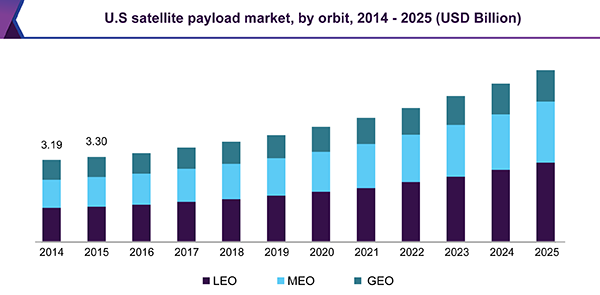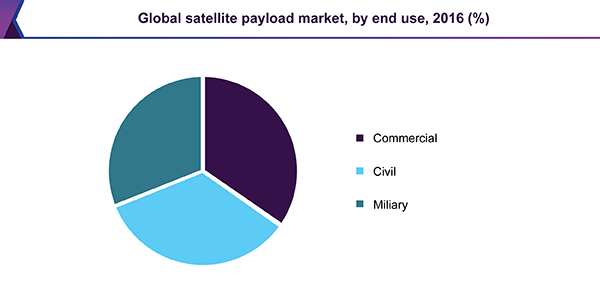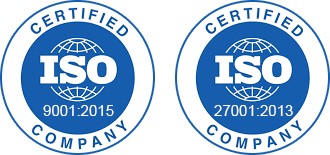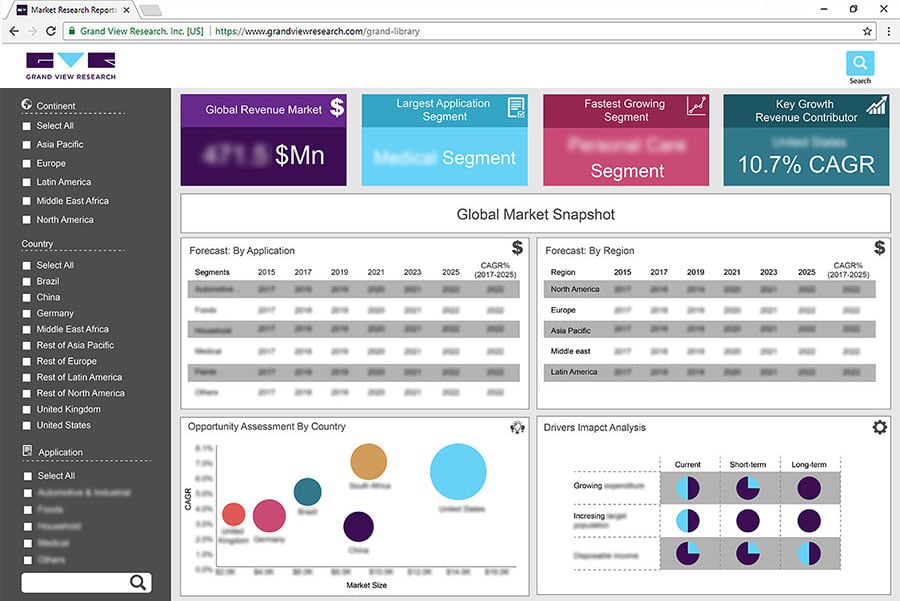- Home
- »
- Communication Services
- »
-
Satellite Payloads Market Size, Share & Trends Report, 2025GVR Report cover
![Satellite Payloads Market Size, Share & Trends Report]()
Satellite Payloads Market Size, Share & Trends Analysis Report By Orbit (LEO, MEO, GEO), By Application (Communication & Navigation, Remote Sensing, Surveillance), By End Use, By Region, And Segment Forecasts, 2018 - 2025
- Report ID: GVR-1-68038-876-3
- Number of Report Pages: 120
- Format: PDF, Horizon Databook
- Historical Range: 2017 - 2025
- Forecast Period: 2017 - 2025
- Industry: Technology
Industry Insights
The global satellite payloads market size was estimated at USD 11.25 billion in 2016. Significant innovations in communication & navigation applications such as Radio Frequency (RF) payload systems, flexible payloads, and advanced regenerative payloads are contributing to industry growth.
The growing trend of miniaturization has resulted in the development of small radar cameras and sensors that are commonly attached to large satellites for producing high-quality images of the earth’s surface. These small satellites are equipped with payloads that provide information about the land cover characteristics, urban regions, and other multi-purpose images. However, high design and manufacturing costs are expected to pose a serious challenge to market growth over the next few years.

Flexible payloads are witnessing a rise in popularity as they can modify antenna beam patterns in orbit to respond to market demands. For instance, Airbus S.A.S. has designed a high power multi-beam broadcast antenna to allow operators to configure shaped beams for their customers with the help of flexible payloads.
Digital payloads are gaining prominence as they are transforming the industry by allowing bandwidth to be switched between different transponders. These payloads are expected to change the cost structure of the satellite industry with their increasing adoption for various applications and services. They also allow end users to use smaller and affordable antennas on the ground to offer a cost advantage, leading manufacturers to provide smaller antennas that can automatically lock on to the satellites.
Moreover, the emergence of Digital Transparent Processor (DTP) is expected to transform the market as it uses multiple beams from the satellite and combines them into a single loop to connect them to multiple gateways seamlessly and efficiently. These processors offer flexibility regarding connectivity to overcome connection and channelization concerns.
Orbit Insights
The Low Earth Orbit (LEO) satellite payloads significantly contributed to the industry growth with a revenue share of over 35% in 2016. Since these satellites provide a clear portrait of the surface of the earth along with a minute level of detail, they have gained considerable prominence. These payloads also provide end users with low-risk access to orbit, cost-effective space quality, efficient in-orbit data, and mission continuity competence. The hosted payload approach has been widely used in many LEO and Geostationary Equatorial Orbit (GEO) missions such as Sapphire, GIOVE-A, UK-DMC-2, and TechDemoSat-1.
Furthermore, the growing number of LEO payloads has increased the opportunities for launch service providers to develop dispenser systems for the deployment of multiple satellites in LEO orbits. The increase in the demand for C-band and Ku-band GEO satellites have affected the hardware that is integrated into the satellites, enabling suppliers to develop technologies for achieving higher performance while attempting to keep launch mass low. GEO satellite finds applications in direct-to-home broadcasting, internet, and regional mobile telecommunications services.
Increasing government regulations have led to the emergence of hosted payloads that operate independently by harnessing power from the satellite. The U.S. military widely adopts both GEO and LEO satellites that provide detailed radar images of small and strategic locations to gather signals and transmit them to the soldiers. Additionally, they are also used to direct precision-guided weapons by directing down laser beams to the surface.
Application Insights
The communication & navigation segment contributed significantly to industry growth in 2016 as the telecommunication segment has witnessed high adoption of flexible payloads. One of the key trends driving the communication & navigation segment is the emergence of High Throughput Satellites (HTS). The significant decrease in the price of data and the massive increase in CAPEX efficiencies of satellites have transformed the communication industry.
Communication payloads have witnessed new technology trends including channelization, space-based inflatable reflector antenna, internet routers in space, and the development of power amplifiers. The payloads have helped in providing insights on the niche areas such as air & sea coverage by way of integrating with terrestrial systems.
Moreover, payloads are widely used for remote sensing applications in the fields of agriculture for crop monitoring, land use mapping, watercourse monitoring, and disaster monitoring & mitigation. Recent innovations such as digital sensors in remote sensing can scan large areas of the earth’s surface and beam this data to satellite ground stations.
End-Use Insights
The commercial sector dominated the industry with a revenue share of over 30% in 2016. The increased demand for commercial payloads can be attributed to the elevating need for broadband internet services and high-definition videos. The need for such high-definition videos has increased the demand for higher satellite capacity, enabling players to expand their in-orbit fleets.

Furthermore, as commercial satellites can be easily programmed and launched, they are one of the popular alternatives among end-use industries. The deliberate shift in federal policy to encourage private sector satellite launches is expected to impact industry growth over the next few years positively. With the increasing demand for telecommunication and earth observation satellites, the commercial segment is expected to evolve over the forecast period.
Moreover, due to the high requirements for earth observation data, the launching of payloads have increased significantly. The earth observation mission provides data that is accurate, has spatial and global coverage along with high precision. The payloads sent for earth observation are commercially exploited and make a significant contribution to the accurate forecasting and monitoring of economic and political parameters.
Regional Insights
North America dominated the industry in 2016 as a maximum number of satellite launches were observed in the U.S. Moreover, the presence of key players and the increased government spending on space technologies is contributing to regional growth. Recently, the U.S. military launched a military communication satellite that is expected to increase communication with soldiers and can accommodate voice, data, and video over a broad range of ground-based and mobile terminals.
The European regional market held a revenue share of more than 25% in 2016. The increasing spending on telecommunication and earth observation satellites in the UK is expected to contribute significantly to the market demand. Other major factors driving regional growth include the increased commercialization of space and the surge in the regional space industry. However, factors such as the lack of collaboration among member states and insufficient support for the downstream sector are expected to limit the growth of the European market.
Satellite Payloads Market Share Insight
Key industry players include Airbus Group, Honeywell International Inc., Lockheed Martin Corporation, Raytheon Corporation, and The Boeing Company. Players are engaged in mergers, acquisitions, and partnerships to gain an advantage over competitors. For instance, in March 2016, the Airbus Group acquired Navtech with a view to offering end-to-end flight operation services by providing solutions for electronic flight bags, aeronautical charts, navigation data, performance-based navigation, flight planning, aircraft performance, and crew planning.
Additionally, manufacturers are offering and developing new technologies that alter the cost capability dynamics of payloads. For example, miniaturization has garnered increased importance over the past few years as it is well suited for data gathering and scientific observations
Recent Development
- In January 2023, Airbus signed a contract with the Belgian Ministry of Defence to offer the defense force with a new UHF satellite communications service. The new payload aims to further enhance Airbus's portfolio throughout the lifespan of the satellite
Report Scope
Attribute
Details
Base year for estimation
2016
Forecast period
2017 - 2025
Market representation
Market revenue in USD Billion & CAGR from 2017 to 2025
Regional scope
North America, Europe, Asia Pacific, Latin America, and MEA
Country scope
U.S., Canada, U.K., Germany, China, India, Japan, Brazil, and Mexico
Report coverage
Revenue forecast, company share, competitive landscape, growth factors, and trends
15% free customization scope (equivalent to five analyst working days)
If you need specific market information that is not currently within the scope of the report, we will provide it to you as a part of the customization
Segments Covered in the ReportThis report forecasts revenue growth at the global, regional, and country levels and provides an analysis of the market trends in each of the sub-segments from 2016 to 2025. For the purpose of this study, Grand View Research has segmented the global satellite payloads market based on orbit, application, end use, and region.
-
Orbit Outlook (Revenue, USD Billion; 2014 - 2025)
-
Low Earth Orbit (LEO)
-
Medium Earth Orbit (MEO)
-
Geostationary Earth Orbit (GEO)
-
-
Application Outlook (Revenue, USD Billion; 2014 - 2025)
-
Communication & Navigation
-
Remote Sensing
-
Surveillance
-
Others
-
-
End-Use Outlook (Revenue, USD Billion; 2014 - 2025)
-
Civil
-
Military
-
Commercial
-
-
Regional Outlook (Revenue, USD Billion; 2014 - 2025)
-
North America
-
The U.S.
-
Canada
-
-
Europe
-
Germany
-
The U.K.
-
-
Asia Pacific
-
China
-
India
-
Japan
-
-
Latin America
-
Brazil
-
Mexico
-
-
MEA
-
Share this report with your colleague or friend.
![gvr icn]()
NEED A CUSTOM REPORT?
We can customize every report - free of charge - including purchasing stand-alone sections or country-level reports, as well as offer affordable discounts for start-ups & universities. Contact us now
![Certified Icon]()
We are GDPR and CCPA compliant! Your transaction & personal information is safe and secure. For more details, please read our privacy policy.
We are committed towards customer satisfaction, and quality service.
"The quality of research they have done for us has been excellent."





